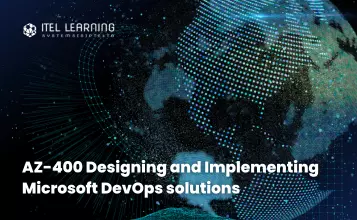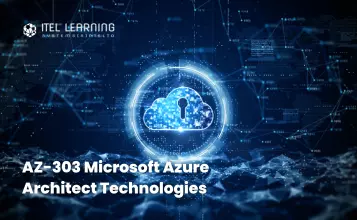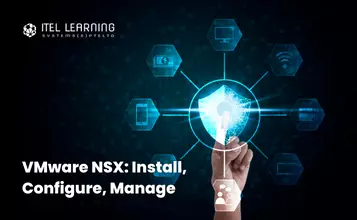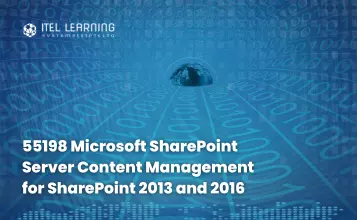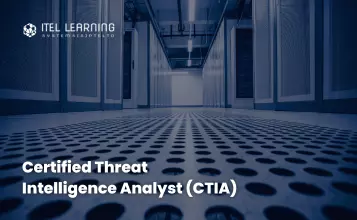Overview
This course provides the knowledge and skills to design and implement DevOps processes and practices. Students will learn how to plan for DevOps, use source control, scale Git for an enterprise, consolidate artifacts, design a dependency management strategy, manage secrets, implement continuous integration, implement a container build strategy, design a release strategy, set up a release management workflow, implement a deployment pattern, and optimize feedback mechanisms.
Prerequisites
Successful learners will have prior knowledge and understanding of:
- Cloud computing concepts, including an understanding of PaaS, SaaS, and IaaS implementations
- Both Azure administration and Azure development with proven expertise in at least one of these areas
- Version control, Agile software development, and core software development principles. It would be helpful to have experience in an organization that delivers software
Course Duration
4 Days
Course Outline
- What is DevOps?
- Explore the DevOps journey
- Identify transformation teams
- Explore shared goals and define timelines
- Explore greenfield and brownfield projects
- Decide when to use greenfield and brownfield projects
- Decide when to use systems of record versus systems of engagement
- Identify groups to minimize initial resistance
- Identity project metrics and key performance indicators (KPIs)
- Explore agile development practices
- Explore principles of agile development
- Define organization structure for agile practices
- Explore ideal DevOps team members
- Enable in-team and cross-team collaboration
- Select tools and processes for agile practices
- What is Azure DevOps?
- What is GitHub?
- Explore an authorization and access strategy
- Migrate or integrate existing work management tools
- Migrate or integrate existing test management tools
- Design a license management strategy
- Introduction to GitHub Projects and Project boards
- Introduction to Azure Boards
- Link GitHub to Azure Boards
- Configure GitHub Projects
- Manage work with GitHub Project boards
- Customize Project views
- Collaborate using team discussions
- Agile plan and portfolio management with Azure Boards
- Explore DevOps foundational practices
- What is source control?
- Explore benefits of source control
- Explore best practices for source control
- Understand centralized source control
- Understand distributed source control
- Explore Git and Team Foundation Version Control
- Examine and choose Git
- Understand objections to using Git locally
- Introduction to Azure Repos
- Introduction to GitHub
- Migrate from TFVC to Git
- Use GIT-TFS
- Develop online with GitHub Codespaces
- Version Control with Git in Azure Repos
- Explore monorepo versus multiple repos
- Implement a change log
- Explore branch workflow types
- Explore feature branch workflow
- Explore Git branch model for continuous delivery
- Explore GitHub flow
- Explore fork workflow
- Version control with Git in Azure repos
- Collaborate with pull requests
- Exercise – Azure Repos collaborating with pull requests
- Examine GitHub mobile for pull request approvals
- Examine code quality
- Examine complexity and quality metrics
- Introduction to technical debt
- Measure and manage technical debt
- Integrate other code quality tools
- Plan effective code reviews
- Introduction to Git hooks4 min
- Implement Git hooks
- Explore foster inner source
- Implement the fork workflow
- Describe inner source with forks
- Explore foster inner source
- Implement the fork workflow
- Describe inner source with forks
- Explore the concept of pipelines in DevOps
- Describe Azure Pipelines
- Understand Azure Pipelines key terms
- Choose between Microsoft-hosted versus self-hosted agents
- Explore job types
- Introduction to agent pools
- Explore predefined agent pool
- Understand typical situations for agent pools
- Communicate with Azure Pipelines
- Communicate to deploy to target servers
- Examine other considerations
- Describe security of agent pools
- Understand parallel jobs
- Estimate parallel jobs
- Describe Azure Pipelines and open-source projects
- Explore Azure Pipelines and Visual Designer
- Describe Azure Pipelines and YAML
- Introduction to continuous integration
- Learn the four pillars of continuous integration
- Explore benefits of continuous integration
- Describe build properties
- Enable Continuous Integration with Azure Pipelines
- Configure agent demands
- Implement multi-agent builds
- Explore source control types supported by Azure Pipelines
- Describe the anatomy of a pipeline
- Understand the pipeline structure
- Detail templates
- Explore YAML resources
- Use multiple repositories in your pipeline
- Integrate external source control with Azure Pipelines
- What are Actions?
- Explore Actions flow
- Understand workflows
- Describe standard workflow syntax elements
- Explore events
- Explore jobs
- Explore runners
- Examine release and test an action
- Describe continuous integration with actions
- Examine environment variables
- Share artifacts between jobs
- Examine Workflow badges
- Describe best practices for creating actions
- Mark releases with Git tags
- Create encrypted secrets
- Use secrets in a workflow
- Implement GitHub Actions For CI/CD
- Examine structure of containers
- Work with Docker containers
- Understand Dockerfile core concepts
- Examine multi-stage Dockerfiles
- Examine considerations for multiple stage builds
- Explore Azure container-related services
- Deploy Docker containers to Azure App Service web apps
- Explore traditional IT development cycle
- What is continuous delivery?
- Move to continuous delivery
- Understand releases and deployments
- Understand release process versus release
- Describe Azure DevOps release pipeline capabilities
- Explore release pipelines
- Explore artifact sources
- Choose the appropriate artifact source
- Exercise – Select an artifact source
- Examine considerations for deployment to stages
- Exercise – Set up stages
- Explore build and release tasks
- Explore custom build and release tasks
- Explore release jobs
- Configure Pipelines as Code with YAML
- Understand the delivery cadence and three types of triggers
- Exercise – Select your delivery and deployment cadence
- Explore release approvals
- Exercise – Set up manual approvals
- Explore release gates
- Use release gates to protect quality
- Control deployments using release gates
- Provision and configure target environments
- Exercise – Set up service connections
- Configure automated integration and functional test automation
- Understand Shift-left
- Set up and run availability tests
- Explore Azure Load Testing
- Set up and run functional tests
- Examine task groups
- Exercise – create and manage task groups
- Explore variables in release pipelines
- Understand variable groups
- Exercise – create and manage variable groups
- Automate inspection of health
- Explore events and notifications
- Explore service hooks
- Exercise – Set up service hooks to monitor the pipeline
- Configure Azure DevOps notifications
- Configure GitHub notifications
- Explore how to measure quality of your release process
- Examine release notes and documentation
- Examine considerations for choosing release management tools
- Explore common release management tools
- Explore common release management tools
- Create a release dashboard
- Explore microservices architecture
- Examine classical deployment patterns
- Understand modern deployment patterns
- What is blue-green deployment?
- Explore deployment slots
- Exercise – set up a blue–green deployment
- Introduction to feature toggles
- Describe feature toggle maintenance
- Explore canary releases
- Examine Traffic Manager
- Understand dark launching
- What is A/B testing?
- Explore CI-CD with deployment rings
- Exercise – Ring-based deployment
- Integrate GitHub with single sign-on (SSO)
- Explore service principals
- Explore Managed Identity
- Rethink application configuration data
- Explore separation of concerns
- Understand external configuration store patterns
- Introduction to Azure App Configuration
- Examine Key-value pairs
- Examine App configuration feature management
- Integrate Azure Key Vault with Azure Pipelines
- Manage secrets, tokens and certificates
- Examine DevOps inner and outer loop
- Integrate Azure Key Vault with Azure DevOps
- Enable Dynamic Configuration Feature Flags
- Explore environment deployment
- Examine environment configuration
- Understand imperative versus declarative configuration
- Understand idempotent configuration
- Why use Azure Resource Manager templates?
- Explore template components
- Manage dependencies
- Modularize templates
- Manage secrets in templates
- What is Azure CLI?
- Work with Azure CLI
- Exercise – Run templates using Azure CLI
- Create automation accounts
- What is a runbook?
- Understand automation shared resources
- Explore runbook gallery
- Examine webhooks
- Explore source control integration
- Explore PowerShell workflows
- Create a workflow
- Exercise – Create and run a workflow runbook
- Examine checkpoint and parallel processing
- Understand configuration drift
- Explore Desired State Configuration (DSC)
- Explore Azure Automation State configuration (DSC)
- Examine DSC configuration file
- Exercise – Import and compile
- Exercise – Onboard machines for management
- Explore hybrid management
- What is Bicep?
- Install Bicep
- Exercise – Create Bicep templates
- Understand Bicep file structure and syntax
- Exercise – Deploy a Bicep file from Azure Pipelines
- Exercise – Deploy a Bicep file from GitHub workflows
- Describe SQL injection attack
- Understand DevSecOps
- Explore Secure DevOps Pipeline
- Explore key validation points
- Explore continuous security validation
- Understand threat modelling
- Exercise threat modelling
- Explore how software is built
- What is open-source software
- Explore corporate concerns with open-source software components
- Introduction to open-source licenses
- Explore common open-source licenses
- Inspect and validate code bases for compliance
- Explore software composition analysis
- Integrate WhiteSource with Azure DevOps pipeline
- Implement GitHub Dependabot alerts and security updates
- Integrate software composition analysis checks into pipelines
- Examine tools for assess package security and license rate
- Interpret alerts from scanner tools
- Implement Security and Compliance in an Azure Pipeline
- Explore SonarCloud
- Explore CodeQL in GitHub
- Manage technical debt with SonarCloud and Azure DevOps
- Plan Implement OWASP Secure Coding Practices
- Explore OWASP ZAP penetration test
- Explore OWASP ZAP results and bugs
- Implement pipeline security
- Explore Microsoft Defender for Cloud
- Examine Microsoft Defender for Cloud usage scenarios
- Explore Azure Policy
- Understand policies
- Explore initiatives
- Explore resource locks
- Explore Azure Blueprints
- Understand Microsoft Defender for Identity
- What is dependency management?
- Describe elements of a dependency management strategy
- Identify dependencies
- Understand source and package componentization
- Decompose your system
- Scan your codebase for dependencies
- Explore packages
- Understand package feeds
- Explore package feed managers
- Explore common public package sources
- Explore self-hosted and SaaS based package sources
- Consume packages
- Introduction to Azure Artifacts
- Publish packages
- Identify existing artifact repositories
- Migrate and integrating artifact repositories
- Secure access to package feeds
- Examine roles
- Examine permissions
- Examine authentication
- Understand versioning of artifacts
- Explore semantic versioning
- Examine release views
- Promote packages
- Exercise – Promote a package
- Explore best practices for versioning
- Exercise – Push from the pipeline
- Publish packages
- Install a package
- Delete and restore a package
- Explore package access control and visibility
- Understand the inner loop
- Introduction to continuous monitoring
- Explore Azure Monitor and Log Analytics
- Examine Kusto Query Language (KQL)
- Explore Application Insights
- Implement Application Insights
- Exercise – Add Application Insights to an ASP.NET core application
- Monitor application performance with Application Insights
- Explore Azure Dashboards
- Examine view designer in Azure Monitor
- Explore Azure Monitor workbooks
- Explore Power BI
- Build your own custom application
- Share acquired knowledge within development teams
- Introduction to Azure DevOps project wikis
- Integrate with Azure Boards
- Integrate Azure DevOps and Teams
- Share team knowledge using Azure Project Wiki
- Explore rapid responses and augmented search
- Integrate telemetry
- Examine monitoring tools and technologies
- Examine when get a notification
- Explore how to fix it
- Explore smart detection notifications
- Improve performance
- Understand server response time degradation
- Reduce meaningless and non-actionable alerts
- Examine blameless retrospective
- Develop a just culture
